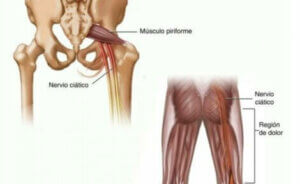How to Stretch Your Piriformis Muscle

If you want to be able to stretch your muscles properly, you need to know a bit more about them before you get started. Because problems with the gluteal area can cause significant issues in everyday life, knowing how to stretch the piriformis muscle can be a big help. We’ll tell you more about this in this article.
The piriformis muscle is located deep in the buttock, near the top of the hip joint. It originates from the anterior part of the sacrum and inserts at the superior border of the greater trochanter.
In the anatomical position, with the hip in the neutral position, the piriformis muscle is considered an external (or lateral) rotator. One clear example of how the piriformis muscle is used is when pitching or batting in baseball, where the hip has to rotate laterally.

Interestingly, when the hip is at a 90-degree angle, the function of the piriformis changes. In this position, the muscle is responsible for internal rotation. As a result, many exercises designed to stretch the piriformis muscle are done with the hip flexed and are designed to promote external rotation.
Piriformis syndrome or pseudo sciatica
Piriformis syndrome is a type of compressive nerve syndrome, in which the sciatic nerve is compressed by the piriformis muscle (Mendoza, Almejo, Correa, Becerra, Sahagún, Rivera & Heredia, 2014).
The sciatic nerve passes just below the piriformis and, in some cases, can even pass through the muscle. Cramps or inflammation of the piriformis can put pressure on the sciatic nerve, leading to pain and discomfort.
This pain is mainly centered on the gluteal area, but can also extend to the lumbar region and down the backs of the thighs. It’s often confused with sciatica. However, the two are, in fact, separate conditions, as sciatic pain originates from the spinal column.

How to stretch your piriformis muscle
There are a number of stretches you can use to help relieve pain or discomfort in the piriformis muscle. These will help to relax the muscle, thus taking pressure off the sciatic nerve.
Taking into account that, with the hip flexed, the function of the piriformis is abduction and internal rotation, you need to do the opposite to really stretch this muscle. This is also the point where the muscle is most extended.
To achieve the best possible piriformis stretch, the following exercises are done with the hip flexed, rotating externally to achieve hip adduction (Gulledge, Marcellin, Tillman, Harrysson, Osborne & Baxter, 2014).
Supine right piriformis muscle stretch
- To start this stretch, lie face up on a yoga mat.
- Bend your left leg, keeping the sole of your foot resting on the floor.
- Cross your right leg over your left, placing your right ankle on your left thigh, just above the knee, so that your right knee is pointing to the right. In this position, both legs should form a triangle.
- Place one hand on either side of your left leg. Then, using both hands, pull your left leg up toward your chest.
- To stretch your left piriformis, repeat the same steps, using the opposite legs.

Seated right piriformis stretch
- Start by sitting on a yoga mat, with your knees bent and the soles of your feet placed firmly on the floor.
- Cross your right leg over your left, so that your right ankle rests against your left thigh.
- Once both legs form a triangle, place your hands on the ground just behind you for support.
- Using your hands, take small steps forward, pushing your body at the same time, until you feel a slight tension in the deep muscles of your hips.
Right piriformis chair stretch
- Sitting on a chair, cross your right leg over your left thigh, so that your right ankle rests just above your left knee.
- Making sure that your legs form a triangle, you can now start to stretch your hip. To do this, sit as straight as possible and lean forward, bringing your chest toward your legs.

Things to remember
All of these exercises will help to stretch the piriformis muscle. However, it’s important to use the stretches which are best suited to you and your particular situation. We would also recommend that you try to control your breathing while performing these muscle stretches. As you breathe out, try to progressively increase your range of movement.
At the same time, however, it’s important not to force these stretches. You must allow your muscles to stretch almost naturally, with the help of deep breathing. Finally, we would advise that you focus all your attention on the muscle you want to stretch, and try to relax.
If you want to be able to stretch your muscles properly, you need to know a bit more about them before you get started. Because problems with the gluteal area can cause significant issues in everyday life, knowing how to stretch the piriformis muscle can be a big help. We’ll tell you more about this in this article.
The piriformis muscle is located deep in the buttock, near the top of the hip joint. It originates from the anterior part of the sacrum and inserts at the superior border of the greater trochanter.
In the anatomical position, with the hip in the neutral position, the piriformis muscle is considered an external (or lateral) rotator. One clear example of how the piriformis muscle is used is when pitching or batting in baseball, where the hip has to rotate laterally.

Interestingly, when the hip is at a 90-degree angle, the function of the piriformis changes. In this position, the muscle is responsible for internal rotation. As a result, many exercises designed to stretch the piriformis muscle are done with the hip flexed and are designed to promote external rotation.
Piriformis syndrome or pseudo sciatica
Piriformis syndrome is a type of compressive nerve syndrome, in which the sciatic nerve is compressed by the piriformis muscle (Mendoza, Almejo, Correa, Becerra, Sahagún, Rivera & Heredia, 2014).
The sciatic nerve passes just below the piriformis and, in some cases, can even pass through the muscle. Cramps or inflammation of the piriformis can put pressure on the sciatic nerve, leading to pain and discomfort.
This pain is mainly centered on the gluteal area, but can also extend to the lumbar region and down the backs of the thighs. It’s often confused with sciatica. However, the two are, in fact, separate conditions, as sciatic pain originates from the spinal column.

How to stretch your piriformis muscle
There are a number of stretches you can use to help relieve pain or discomfort in the piriformis muscle. These will help to relax the muscle, thus taking pressure off the sciatic nerve.
Taking into account that, with the hip flexed, the function of the piriformis is abduction and internal rotation, you need to do the opposite to really stretch this muscle. This is also the point where the muscle is most extended.
To achieve the best possible piriformis stretch, the following exercises are done with the hip flexed, rotating externally to achieve hip adduction (Gulledge, Marcellin, Tillman, Harrysson, Osborne & Baxter, 2014).
Supine right piriformis muscle stretch
- To start this stretch, lie face up on a yoga mat.
- Bend your left leg, keeping the sole of your foot resting on the floor.
- Cross your right leg over your left, placing your right ankle on your left thigh, just above the knee, so that your right knee is pointing to the right. In this position, both legs should form a triangle.
- Place one hand on either side of your left leg. Then, using both hands, pull your left leg up toward your chest.
- To stretch your left piriformis, repeat the same steps, using the opposite legs.

Seated right piriformis stretch
- Start by sitting on a yoga mat, with your knees bent and the soles of your feet placed firmly on the floor.
- Cross your right leg over your left, so that your right ankle rests against your left thigh.
- Once both legs form a triangle, place your hands on the ground just behind you for support.
- Using your hands, take small steps forward, pushing your body at the same time, until you feel a slight tension in the deep muscles of your hips.
Right piriformis chair stretch
- Sitting on a chair, cross your right leg over your left thigh, so that your right ankle rests just above your left knee.
- Making sure that your legs form a triangle, you can now start to stretch your hip. To do this, sit as straight as possible and lean forward, bringing your chest toward your legs.

Things to remember
All of these exercises will help to stretch the piriformis muscle. However, it’s important to use the stretches which are best suited to you and your particular situation. We would also recommend that you try to control your breathing while performing these muscle stretches. As you breathe out, try to progressively increase your range of movement.
At the same time, however, it’s important not to force these stretches. You must allow your muscles to stretch almost naturally, with the help of deep breathing. Finally, we would advise that you focus all your attention on the muscle you want to stretch, and try to relax.
All cited sources were thoroughly reviewed by our team to ensure their quality, reliability, currency, and validity. The bibliography of this article was considered reliable and of academic or scientific accuracy.
- Gulledge, B. M., Marcellin-Little, D. J., Levine, D., Tillman, L., Harrysson, O. L., Osborne, J. A., & Baxter, B. (2014). Comparison of two stretching methods and optimization of stretching protocol for the piriformis muscle. Medical Engineering & Physics, 36(2), 212-218.
- Mendoza, I. G., Almejo, L. L., Correa, J. F. C., Becerra, E. N., Sahagún, J. Á. V., Rivera, J. J. Z., & Heredia, J. Á. M. (2014). Síndrome del piramidal (piriforme). HISTORIA, 10(2).
This text is provided for informational purposes only and does not replace consultation with a professional. If in doubt, consult your specialist.








